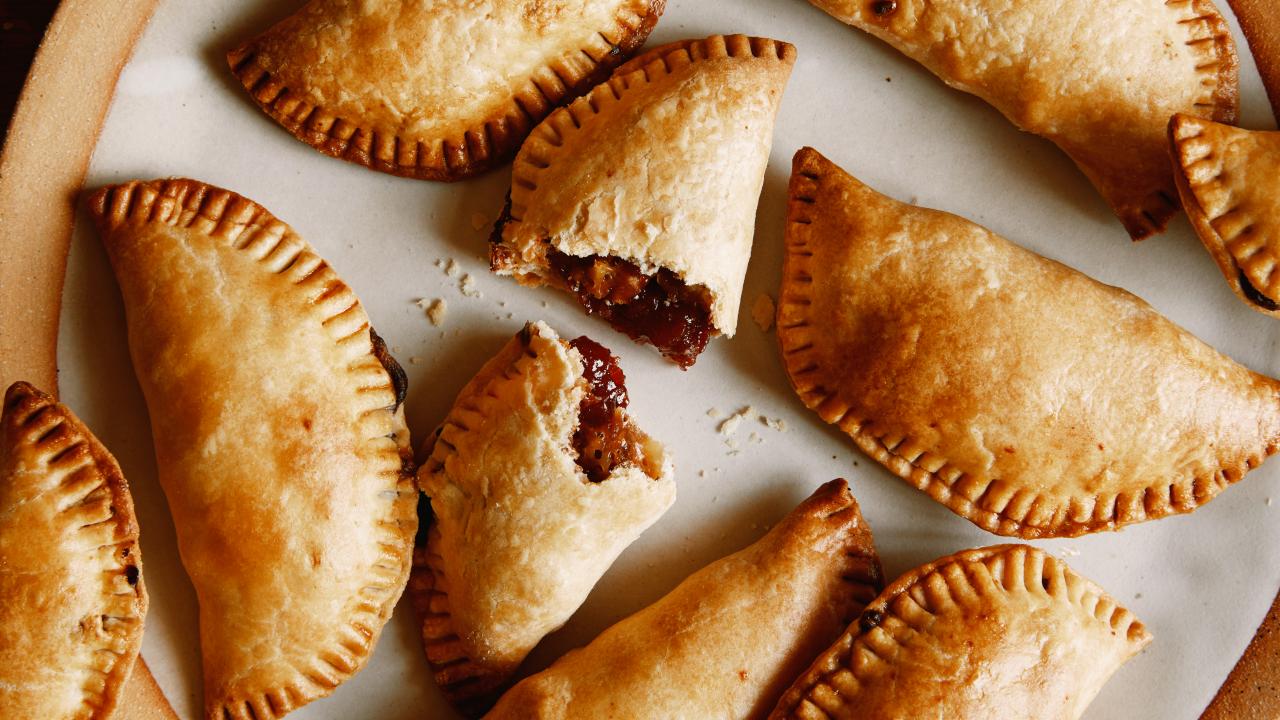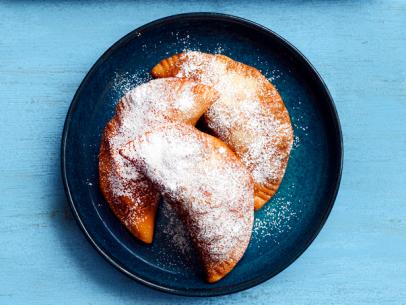Recipe courtesy of
Larisa Alvarez
for
Food Network Kitchen
Recipe courtesy of
Larisa Alvarez
for
Food Network Kitchen
Watch how to make this recipe.
Cheesy Guava Empanadas
Getting reviews...
- Level: Easy
- Total: 50 min
- Active: 20 min
- Yield: 10 empanadas
-
- Nutritional Analysis
- Per Serving
- Serving Size
- 1 of 10 servings
- Calories
- 191
- Total Fat
- 8 g
- Saturated Fat
- 4 g
- Carbohydrates
- 24 g
- Dietary Fiber
- 2 g
- Sugar
- 3 g
- Protein
- 6 g
- Cholesterol
- 41 mg
- Sodium
- 266 mg
When we were growing up, my mother would serve us slices of guava paste with cream cheese on the side for dessert and my father would eat sweet jams with savory cheeses for breakfast. These components come together in this empanada recipe: the cream cheese adds creaminess and tang, while the saltiness of the queso duro balances out the sweetness of the guava. It’s an easy assembly and the result can be eaten for any meal, or as a sweet and savory snack.
- Level: Easy
- Total: 50 min
- Active: 20 min
- Yield: 10 empanadas
-
- Nutritional Analysis
- Per Serving
- Serving Size
- 1 of 10 servings
- Calories
- 191
- Total Fat
- 8 g
- Saturated Fat
- 4 g
- Carbohydrates
- 24 g
- Dietary Fiber
- 2 g
- Sugar
- 3 g
- Protein
- 6 g
- Cholesterol
- 41 mg
- Sodium
- 266 mg
Ingredients
Directions
- Preheat the oven to 375 degrees F. Spray 2 baking sheets with nonstick cooking spray.
- Put 3 or 4 of the empanada wrappers on a flat work surface. Spoon 2 teaspoons of cream cheese on the bottom half of each, then spread to create a half-moon shape, leaving a 1/2-inch gap between the cream cheese and the edge. Divide the guava paste into 1-ounce sections; depending on how the paste is packaged, you can either cut it into planks or scoop out about 3 teaspoons per empanada (using 3 teaspoons rather than 1 tablespoon will make the empanadas easier to seal). Finally, top each empanada with about 2 tablespoons of grated cheese.
- Make an egg wash by whisking the egg in a small bowl with a splash of water. Brush the outer edge of each wrapper with the egg wash, then seal by folding each wrapper in half and pressing the edges together with your fingers. Arrange the empanadas on the prepared baking sheets, then crimp the edges of each with a fork, pushing down enough to seal but not enough to go through the dough. Assemble, seal and crimp the remaining empanadas.
- Brush the top side of each empanada with the egg wash, then bake until the outsides are dark golden brown and feel crispy to the touch, 20 to 25 minutes. Let cool for at least 5 minutes, then serve.
Cook’s Note
The empanada wrappers are easier to work with if they are not fully thawed or warm. Queso duro, which translate to “hard cheese,” can be found in some international aisles and in most Latin groceries. Avoid using queso blanco or Cotija in this recipe--the flavor will be overpowered by the guava.
Looking for Something Else?
Related Pages
- Cheese Empanadas Recipe
- Guava Cheese Turnovers (Guava Pastelillos) Recipe
- Guava Empanadas Recipe
- Poblano Cream Cheese Empanadas Recipe
- Guava Glazed Chicken Thighs Recipe
- Spinach and Cheese Empanadas Recipe
- Guava and Cream Cheese Empanadas Recipe
- Crab and Goat Cheese Empanadas Recipe
- Hot Brown-Stuffed French Toast Recipe


































